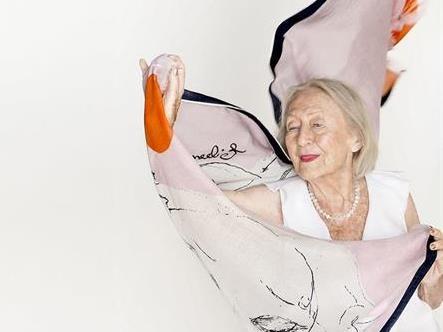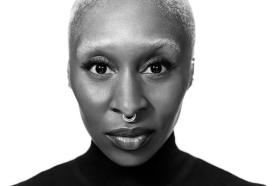101 year old dancer Eileen Kramer models a scarf designed in collaboration with Brigid McLaughlin. Photo Cybele Malinowski
Conventionally, we prepare for retirement by saving – topping up that pool of super with every paycheck. For some, that is not an option. Many artists and actors don’t have the luxury of benefits that come with a full time salary, so the most obvious future for them is simple – don’t retire.
A new study explores whether that is as bleak a prospect as it sounds, and whether the arts is alone in this prolonged work life.
According to a report released by Merrill Edge in the US, 83% of investors under the age of 35 say they plan to work during retirement. That sentiment is not reserved for millennials alone – who have perhaps been nurtured into the idea that retirement comes later. 79% of Generation X and 64% of baby boomers agree.
While working into your 70s and 80s might sustain a lifestyle, for some careers it is unrealistic.
NAVA (National Association for the Visual Arts) recently launched a campaign for equal pay for artists, which included lobbying government for a retirement scheme for the sector.
Read: New campaign calls for fair pay for artists
Does the arts have a career shelf-life?
The US Centre for Retirement Research at Boston College used government data to rate 954 occupations on the likelihood that the skills required would decline with age. While older workers might be more knowledgeable and can work more effectively due to experience, they may also find it more difficult to adopt new skills and process information.
The result was a Susceptibility Index, which ranked professions in their ability to “age well”. A higher number means you are more likely to face decline. Dancers were at the bottom of the list, while Compensation Managers were at the top. We have filtered that Index to see how professions rank with the arts.
Where does your profession sit on the Susceptibility Index?
Visual Arts & Design
- Art Teacher 42
- Interior Designer 56
- Curator 251
- Multimedia Artist and Animator 282
- Architect 359
- Video Game Designer 387
- Graphic Designer 403
- Fashion Designer 419
- Museum Technician and Conservator 426
- Art Therapist 444
- Architectural Draftsperson 505
- Craft Artist 560
- Jeweller 589
- Photographer 671
- Glassblower / Glass artist 790
- Potter 814
Artists, per se, were not included in the Index, perhaps given their difficulty to classify across medium and studio practice. History, however, has shown that artists work well into the aged years. This week Sydney Ball passed away at 83. Last year he launched a new series of work, as did sculptor and artist Ken Unsworth. He likes to collaborate with mature dancers and musicians to create a new piece each. Unsworth told Artshub: ‘Senior artists need, quite often, just as much support as emerging artists. And Australia is not renowned for respecting its older artists.’
Read: Six artists over 80 with current exhibitions
Read: Vale Sydney Ball
Theatre, Performance & Film
- Art Manager or Agent – performance 10
- Talent Director 74
- Producer 82
- Radio and TV Announcer 142
- Music Composer or Arranger 231
- Director – stage, TV, radio and film 277
- Sound Engineer – technical 317
- Film & Video Editor 361
- Art Director 384
- Singer 429
- Music Therapist 450
- Music Director 476
- Set and Exhibition Designer 594
- Make Up Artist – theatrical and performance 653
- Camera Operator 740
- Choreographer 790
- Dancer 954
Eileen Kramer and dancers with the company Australian Dance Artists (ADA) – Anca Frankenhaeuser, Susan Barling, Patrick Harding-Irmer, Ross Philip, and Norman Hall prove this Index wrong. They are all in what would be conventionally labelled as the “retirement bracket”.
Kramer worked with a young fashion designer last year to release a new label, while ADA create new work in collaboration with artist Ken Unsworth each year.
Unsworth said of their collaboration, ‘What we are doing now is a natural follow-on from what I was have always done, but it allows me to be a bit more elaborate. At my age what have I got to loose – I wanted to keep working in that [experimental] way.’
Read: The 101 year old dancer inspiring fashion
Read: The artist as patron
Publishing & Literature
- Copy Writer 41
- Librarian 172
- Editor 272
- Proof Reader 301
- Archivist 321
- Technical Writer 365
- Poet, Lyricist and Creative Writer 404
- Desktop Publisher 662
‘The notion that all white-collar workers can work longer, or that all blue-collar workers cannot, is too simplistic,’ the study’s authors concluded.
The answer why are some white-collar jobs more susceptible than others lies largely in the extent to which they require different types of intelligence. “Fluid intelligence” – your ability to process new information and situations – tends to decline with age. Meanwhile “crystallised intelligence” – your knowledge of facts and how to perform particular tasks – generally increases through your 50s and 60s, with little decline after that.
That’s one of the reasons why designers, copy writers, producers and teachers rank higher on the chart and are less susceptible to decline, than say a dancer, choreographer or a glass artist.





